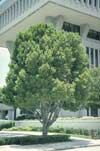Home >
Coccoloba diversifolia, Pigeon Plum
Fast-growing in full sun or partial shade, Pigeon-Plum does best on moist, well-drained soils. It has good salt tolerance. Although Pigeon-Plum makes a wonderful shade tree, the fallen fruit may create a litter problem on patios and sidewalks, and along streets. But the 2-month inconvenience of messy fruit may be outweighed by the bountiful canopy and striking bark. Trees are tolerant of urban conditions and have performed well as street and parking lot trees. Pollen can cause significant allergy symptoms.
Trees in their native forest habitat typically have one leader or trunk for several dozen feet, then trunks divide into several codominant stems toward the top of the tree. Unless properly pruned, trees in more open landscapes develop several codominant stems fairly close to the ground.
This plant is often grown as a multi-trunk tree, but weak, included bark often develops where stems join and where some main branches join with trunk. Though this usually is fine on trees not capable of growing to a large size, it could lead to the stems or branches splitting from the tree in storms. Trees trained with a short, dominant trunk may last longer.
National champion for this Florida native is 49 x 22 feet in Florida. Native range is Cape Canaveral along the coast to Key West and Cape Romano.






